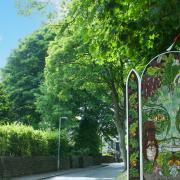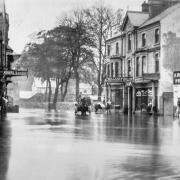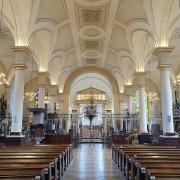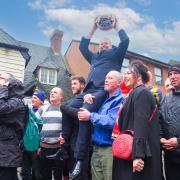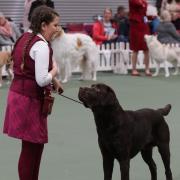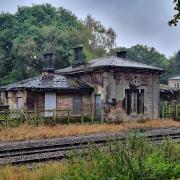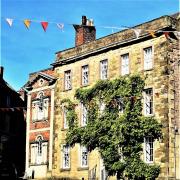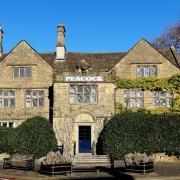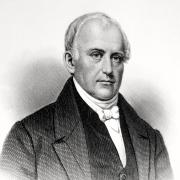Derbyshire is blessed with many eye-catching churches, yet few are as unique as Matlock Dale’s St John the Baptist Church, as Mike Smith discovers.
When you walk up a steep lane known as St John’s Road, reached by turning off the A6 on the western flank of Matlock Dale, you will come across a remarkable edifice built right up against the side of a cliff.
The battlemented retaining wall of the building is formidably blank and sturdy for much of its considerable height, except for a large oriel window protruding from an upper floor.
Given the fairytale appearance of this castle-like structure, it is easy to imagine a beautiful princess being held captive in the room behind the window.

Access to the building is obtained by continuing up St John’s Road for a short distance before turning sharply to the right. A peep through the bars of the perimeter gate brings a complete surprise.
This side of the building is clearly not the entrance to a castle at all, but the frontage of a little country church with a small bell tower and a wooden porch linked to the vestry by an ambulatory.
Known as the Church of St John the Baptist, this place of worship with a split personality was designed in 1897 by Guy Dawber, an architect who would become the first President of the Royal Institute of British Architects.
Commissioned by Louisa Sophia Harris, who lived with her husband, Walter, a well-known local solicitor, at a nearby house called The Rocks, the church was dedicated to the memory of Louisa’s aunt and uncle, from whom she had inherited £10,000.

In the Anglo-Catholic tradition
Explaining why Mrs Harris decided to build her own church, Joan Link, the key-holder for the building, said: ‘She was very upset when the vicar of St Giles’ Church in Matlock refused to allow Vida, her pet dog, to enter his church, and she also thought the vicar’s liturgical practices were not sufficiently ‘high church’ for her tastes.
‘Louisa was wealthy enough to employ some of the best craftspeople working at that time, enabling her to construct a private chapel where she and her like-minded friends could worship in the Anglo-Catholic tradition.’
Decorations in the interior of the church reflect that tradition. The east window's colourful painted glass was designed by Louis Davis, known as ‘the last of the pre-Raphaelites’.
Plaster-work depictions of vines and flying swallows by George Bankart cover the barrel-vaulted ceiling and the painted altarpiece is the work of John Cooke.
Most of the other fixtures and fittings, including the pews, choir stalls, pulpit, rood screen and the mock-medieval wooden door, were probably designed by the architect himself.
Louisa added her own delightful touch by decorating the church with flowers taken from her garden at The Rock, and there is a small plaque under a side window that is dedicated to Vida, who was, of course, warmly welcomed in this place of worship.

Friends
Although the church is no longer open for regular services, individuals and parties wishing to see this wonderful example of an Arts and Crafts interior can arrange a visit by contacting the Friends of Friendless Churches (020 7236 3934).
Because the approach to the church is narrow, steep and twisting and contains no turning places, visitors are asked to leave their cars at the foot of St John’s Road – the walk up to the church requires some effort but it is very rewarding.
The organisation known as Friends of Friendless Churches resulted from a meeting called in 1957 by Ivor Bulmer-Thomas, an academic who was passionate about the preservation of redundant churches.
Distinguished people who responded to his invitation by gathering in Room 13 of the House of Commons, included the politician Joy Jenkins, the artist John Piper and the poets TS Eliot and John Betjeman.

The society that grew out of their deliberations has a mission ‘to save disused but beautiful old places of architectural interest from demolition or unsympathetic conversion’.
Deriving its income from fund-raising, donations, grants and subscriptions paid by its members, the organisation cares for 50 disused churches in England and Wales, including two places of worship in Derbyshire - the chapel in Matlock Dale and the Church of All Saints in Ballidon.
A leaflet published by the Friends describes the Church of St John the Baptist as a building that is ‘perched on a massive, rusticated wall, romantically turreted, as if on a Bavarian mountain’.
Key-holder Joan Link makes a German comparison of her own, describing the wonderful first glimpse of the church, which overlooks the river Derwent from its lofty position, as being like the celebrated view of Burg Eltz, a picturesque medieval castle set high in the hills above the river Moselle.
WHILST YOU ARE THERE

Matlock Bath, located a short distance away in the Derwent Gorge, is overlooked from one side by high limestone crags and from the other flank by a steep hillside dotted with fanciful villas. The inland resort has attractions for people of all ages.
Cable car ride to the Heights
For an exhilarating ride over the Derwent Valley, board a cable car and ascend to the Heights of Abraham, perched 169 meters above the A6. The visitor centre at the summit contains a gift shop, bar, restaurant and terrace café, from which there are spectacular views over the gorge.
Show caverns
The two show caves on the Heights of Abraham are a legacy of lead-mining days. A tour of the Great Masson Cavern takes you on an underground journey to the Great Chamber, whereas a visit to the Great Rutland Cavern allows you to experience a day in the life of a 17th century mining family.
The Peak District Lead Mining Museum
The museum, located in the Edwardian Grand Pavilion, has an enormous water pressure engine as its centrepiece. In addition to various hands-on activities, there is a gift shop with mineral specimens and books for sale.
Gulliver’s Kingdom
This theme park has more than 50 attractions, ranging from a log flume and a ‘drop tower’ to tail-thrashing animatronic dinosaurs and ‘bazooka blasters’. Families are encouraged to bring their own picnics or to extend their stay by booking into one of the 18 family-themed suites, each equipped with a kitchenette, three bunkbeds and a double bed.
Fish ‘n’ chips
Alongside pubs, tearooms and ice-cream parlours, there is a greater concentration of fish and chip shops in Matlock Bath than you are likely to find anywhere else in the country. The riverside resort has been a popular stopping-place for motorcyclists ever since former wartime dispatch riders staged regular reunions in this geographically central location.








